It is so easy to take clean drinking water for granted.
After all, when it’s delivered right to our faucets, we don’t have to think twice about getting sick if we drink or cook with it.
This can put us in a place of comfort but also complacency.
If we lost access to this clean water, would we be prepared to provide our families with clean drinking water?
Would we even know how to provide this water? How do we filter and purify water anyways?
In this article, I will address how you can provide safe, potable drinking water to your family in time of emergency.
I will also go over the best emergency water filters on the market today so you can make an informed purchase.
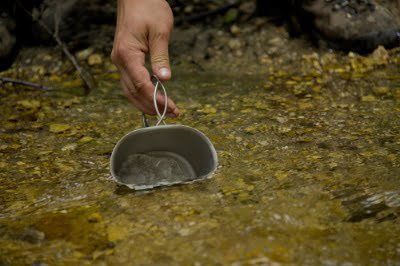
The Basics of Emergency Water Filtration and Purification
There are two steps to getting your water to a safe drinking level:
Step One: Filtration
Filtration is the first step that removes most contaminants. Large debris such as leaves, algae, and sediments are removed along with smaller contaminants that cause cloudiness and bad tastes.
Filtration can also remove VOCs, chlorine, heavy metals, pesticides, herbicides, and more. This is all dependent on the micron size the filter is rated for. You will need to check with the manufacturer to see exactly what the filter can catch per each system.
Step Two: Purification
Once filtered, the purification process then removes bacteria, viruses, and cysts along with chemicals. Although some bacteria are removed through the filtration process, viruses are too small to be caught and require purification to remove completely.
It is absolutely necessary to purify your water! I have noticed through much research that many websites only offer up filtration methods for emergencies, and this will NOT cut the cheese!
You cannot simply run water from the wild through carbon and deem it as safe to drink. Even though the water may look clean, especially from mountain snowmelt, animals can contaminate the water through fecal matter introducing harmful bacteria.

Some of these bacteria are e.Coli and giardia. These bacterium can cause diarrhea which can be deadly in a survival situation.
Viruses are a concern as well, although typically in first world countries it is not nearly as much of a problem. The World Health Organization notes that water can be contaminated with norovirus, rotavirus, and many more.
Scenarios requiring emergency water filtration
Boil order – boil orders are given from health authorities when municipal water sources could be contaminated with pathogens.
Water under boil orders needs to be brought to a rolling boil for a minimum of two minutes.

Municipal water source being shutoff – we’ve all had this happen before, a planned shut off from the city or an unplanned shutoff from someone hitting the main water line. For the first few hours, we go to the faucet expecting water to come out. It is a tolerable situation for a while, but when morning comes around and the water still doesn’t come on, it becomes a bit unnerving! When will the water come back on? I have dishes piling up! I need to take a shower!
Water scarcity/rationing – Now this is probably the lesser common of situations, but if a draught were to be severe and persist over a long period of time, water rationing could be ordered, and possibly even water shutdowns. If that were to happen, water would have to come from the wild.

Flooding and natural disasters – flooding can bring catastrophic amounts of contamination to municipal water sources and well systems. Earthquakes and fires can cause damage to water infrastructures placing you into a possible water emergency.
Scenarios requiring survival water purification
Backwoods trips – If you are going on a prolonged hike or camping trip or are backpacking, you will want to have a portable water purifier handy. No sense in lugging around liters of bottled water if you will have access to water in the wild.

Prolonged emergency situations – If emergency scenarios persist, a mobile water purifier may become necessary if you need to relocate or lose access to municipal water sources entirely.
Off grid lifestyle – You will need a permanent water purification system if you are living the off grid lifestyle and collecting water from a wild source – even rainwater needs purification, mainly due to spontaneous bird turds.
Things to consider when using emergency water filtration
Will you be mobile or stationary?
If you are in a situation where can stay in your home, a whole house water filtration system is a good choice.
If you are in a prolonged emergency situation and must evacuate, a portable water purification option would be essential.
Where will your water come from?

Municipal water on a boil order will require less filtration whereas murky water from the wild will need a more intensive filtration process. It can be hard to know what your water situation will be in a possible future emergency event, but the more scenarios you can apply to your situation, the better prepared you can be.
Will you have access to water at all?
In a water shutdown/scarcity event, you may not have access to conventional water. I suggest locating the nearest water source to your home or bugout location and judge the quality of water to be the best prepared.
How much water will you need?
The WHO made an excellent PDF about emergency water usage, I recommend you download it here.

Having access to clean water is not just for drinking, you will need it to cook and practice safe hygiene practices. Certain activities only required filtered (not necessarily purified) water.
How long will you be surviving on emergency water?
An emergency water situation can quickly turn into a survival water scenario if a perfect storm of events happens. Be prepared for both short term and long term water purification plans.
Uses for Potable Water vs Non Potable Water
Potable water is another term for safe drinking water. This water has been both filtered and purified of contaminants.
Non-potable water may look clean but has not been purified to get rid of viruses and bacteria. However, there are certain water activities that you can perform with non-potable water.
Non-Potable water uses:
- You can water your garden so long as you wash your fruits and veggies first.
- You can take showers as long as you do not consume the water or have open wounds exposed. Personally, I would want to take showers in purified water, if possible.
- Washing your clothes.

- Watering your pets.
- Washing dishes only if you can provide a bleach bath afterward.
- Washing your hands only if you have antibacterial soap or hand sanitizer.
Potable water uses:
- Any water used for drinking.
- Any water used for cooking that has not been brought to a boil.
- Water used for bathing if there are open wounds involved.
DIY emergency water filtration system
I have written a comprehensive guide to all sorts of ways to filter and purify water, I will touch on them lightly here as well.
Natural water filtration methods
Run your water through activated carbon. You can purchase activated carbon or make your own. Now place the carbon at the bottom of a container and layer sand, then gravel on top of it.
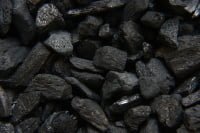
You can dig a hole a few feet from a water source to get cleaner water. Layer some rocks in the hole and then add a top layer of sand.
Filter your water through a ceramic container. This removes a whole lot of particulates and sediments leaving practically clean water. You can use a ceramic gardening pot, as long as you plug the hole on the bottom (duh)!
Natural purification methods
You can use sunlight to purify water! Ah, I love the Sun! It is nature’s way to provide us with clean drinking water without having to use harsh chemicals. I suggest using a glass container instead of plastic as plastic can breakdown from UV exposure. 6 hours of full sunlight will eradicate bacteria and viruses.
Boil your water for one to three minutes.
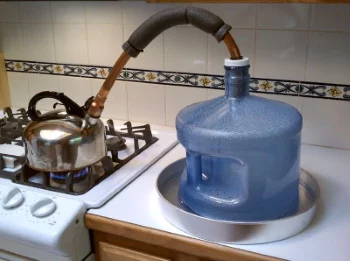
You can use a stovetop still to collect distilled water. Distilled is the same as purified, it just uses the process of distillation to become purified. It also clears out virtually all sediments.
You can use chemicals like bleach, chlorine, and iodine. We don’t want to ingest any more unnecessary chemicals than we have to, but it would behoove you to keep a packet of iodine tablets or a bottle of bleach as a backup purification system if your primary system happens to fail.
Use Shungite stones for purification. Shungite is a type of carbon known as fullerene and only occurs in one spot in the world. Fullerene is a hollow carbon which allows for the absorption of contaminants and microbes, and removes 30 times more free radicals than activated carbon! Just make sure to get the Elite Shungite when purchasing! (source)
I have written a guide on Shungite that you may find interesting.
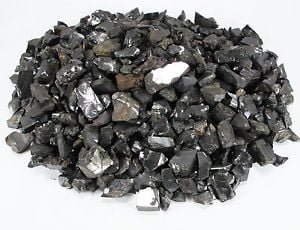
Part Two: The Best Emergency Water Filter Systems on the Market
emergency portable water purification systems
The products discussed in this section are chosen because of their portability and design. These filters are primarily used for the purification of water from the wild and are durable enough to withstand a backwoods survival situation.
These products also work well for long hikes, camping trips, backpacking trips, and expeditions.
Best Overall:
Platypus GravityWorks 4.0 Liter Water Purification System

Pros
- Purified water catches in separate bag
- Produces 1.75 liters of purified water per minute
- Water has a clean fresh taste
- Produces 1.75 liters of purified water per minute
- Water has a clean fresh taste
Cons
- On the more expensive side of filters
- Filters 1500 gallons, less than competitors
- Reports of plastic holes tearing where bag is hung
I give the Platypus GravityWorks filter high remarks because of its “useful life warranty”. Basically, the product is covered for its lifespan as long as you take care of it. The more beat up it gets, the less likely they will cover the product. So if you maintain the product and keep it nice, you have a high probability of having the product covered for many years. You can read about the warranty here.
I also give this filter high remars because it is made of the most excellent quality, in line with all Platypus products.
I like the idea of having a secondary “clean” water bladder catch the purified water as opposed to being on a spigot. If you do not like the clean water bladder design, you can purchase a universal adapter so you can remove the bladder and catch water into several types of vessels.
It does handle quite a bit of water with a decent flow rate, although 1,500 gallons per filter is not the highest filter life, it does provide excellent tasting drinking water.
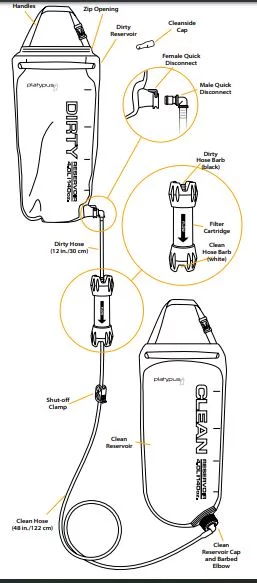
I would recommend immediately reinforcing the plastic where the bladders hang. Users have reported the plastic starts to tear. This can be done easily with some duct tape.
The purifier will not remove chlorine and other chemicals that a municipal water source carries. However, there is a carbon filter that you can purchase additionally that will remove these contaminants.
Overall, this is a really great option for filtering large quantities of water and it provides a clean taste, which is an important element. It is much easier to stay hydrated when your water tastes good. It is a little spendier than other options.
Top Product:
LifeStraw Family 1.0 Portable Gravity Powered Water Purifier
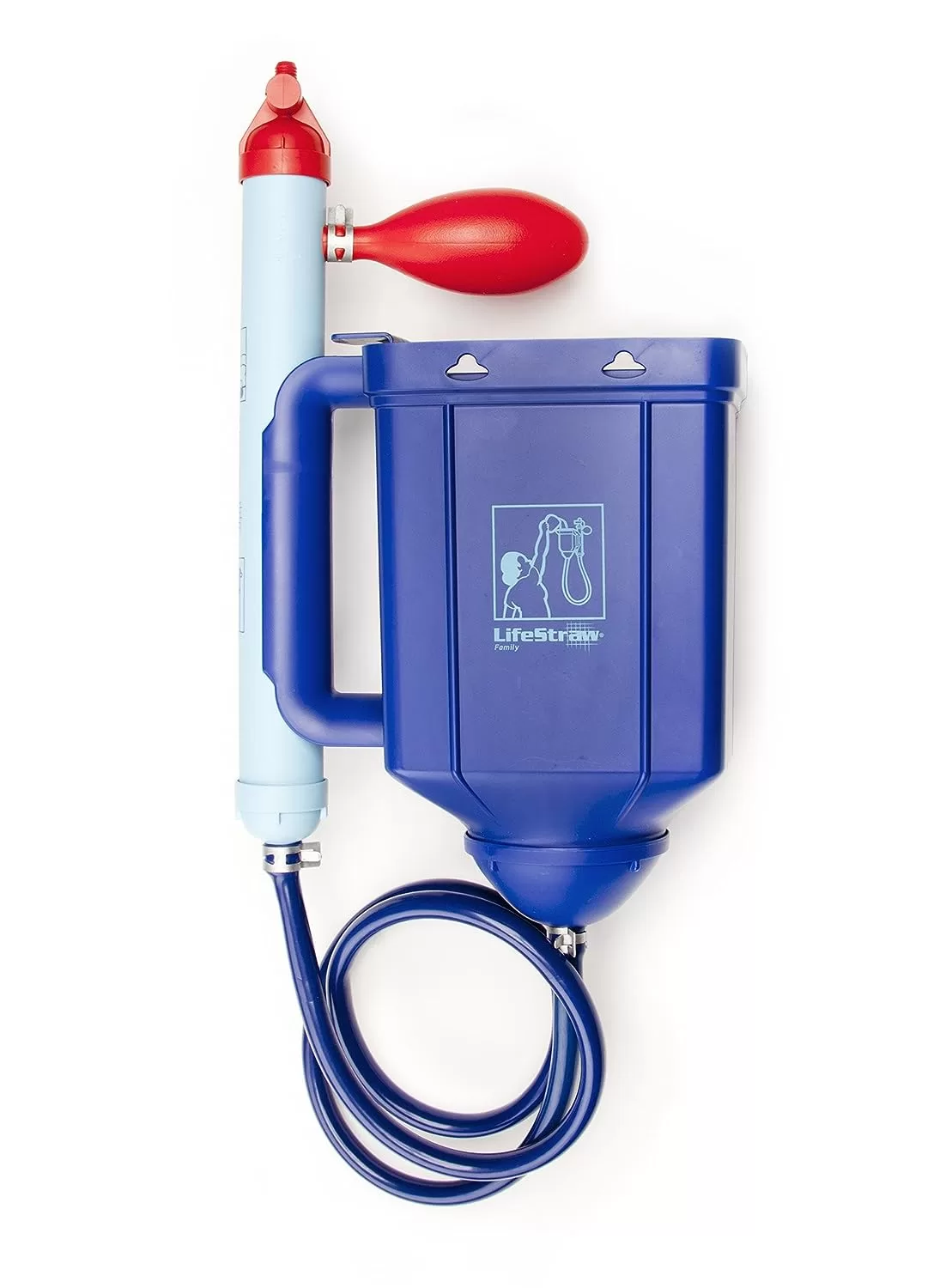
Pros
- Purifies 4,755 gallons of water per filter life
- High flow rate of 9 to 12 liters per hour
- Extremely simple to set up, comes with clear directions
Cons
- Will not remove chemicals or chlorine
- Some reports of a plastic taste
- Water container is somewhat bulky
This LifeStraw family gravity water purifier can be a lifesaver in an emergency water situation and be a solution for long hikes and camping trips. Imagine not having to haul in your own water on such long trips, joy!
It is a gravity-fed filter system so no need to worry about electricity or batteries. There is also no moving parts so less chance of product failure.
The packaging states that it will expire in three years, but that is contingent upon heat exposure of the product. It will not expire if stored in a cool, dry, and dark space.
The hard blue vessel can be bulky to haul around. If that is an issue, you can replace the vessel with a water bladder.
This type of purifier is meant for wild water, I do not recommend using it for municipal water as it does not remove chlorine or chemicals.
Overall, this is a great option for families as it purifies large quantities of water and is good for long trips.
Best Buy:
Sawyer MINI Water Purification System
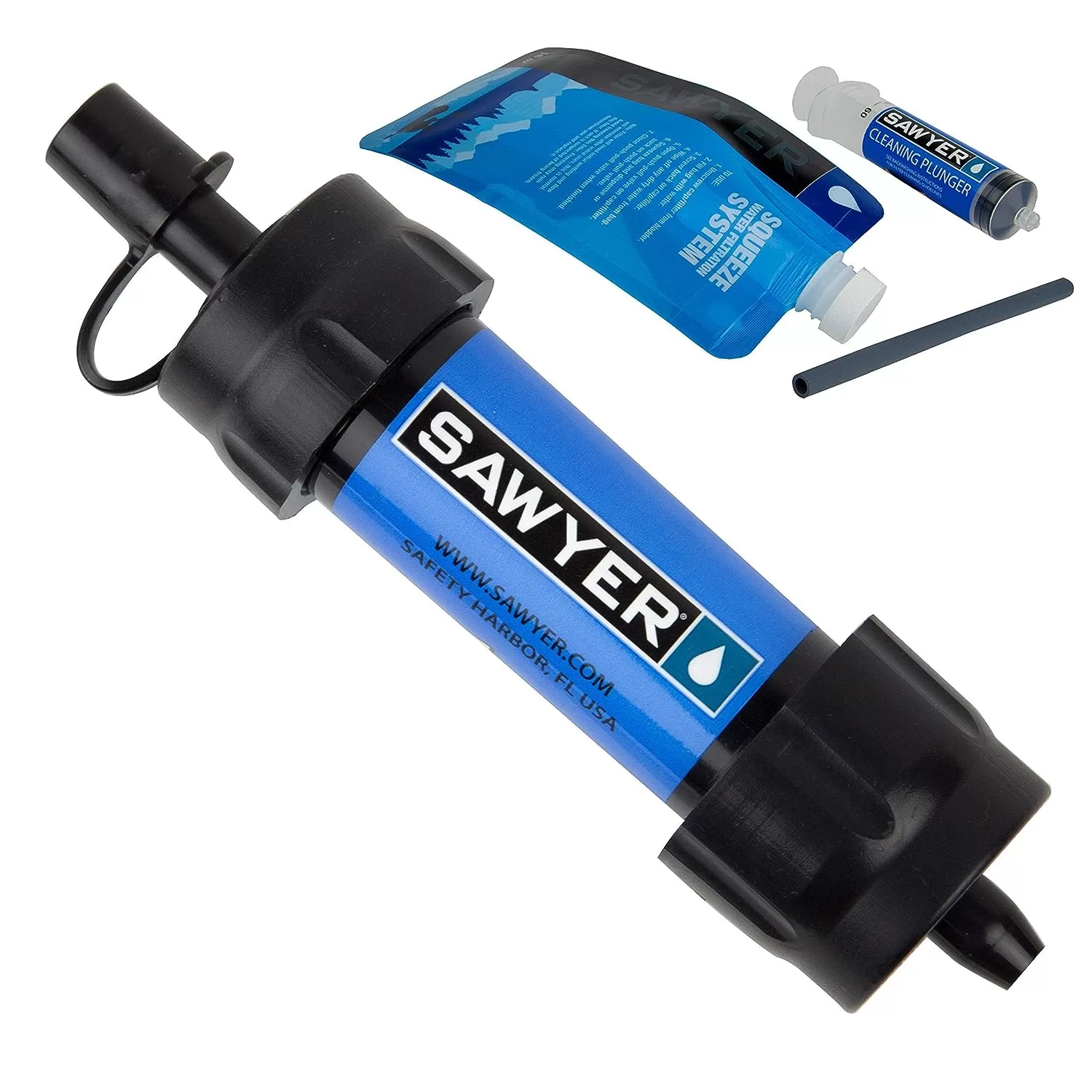
Pros
- Purifies and IMPRESSIVE 100,000 gallons of water!
- Squeeze filtration technology
- Removes E. Coli, Giardia, Salmonella and other bacteria
Cons
- Does not remove viruses – do not use abroad
- Filter needs to be backwashed every 5 to 10 gallons
- Some users report leakage
These Sawyer mini water purifiers are really handy! They are compact in size and very light for good portability.
The squeeze technology is a good system as you can squeeze water out of the bag into a vessel or straight into your mouth.
The filter lasts for a stunning 100,000 gallons! I was shocked and amazed by this number, but mainly skeptical. I have done a ton of research on water purification and this number is staggering.
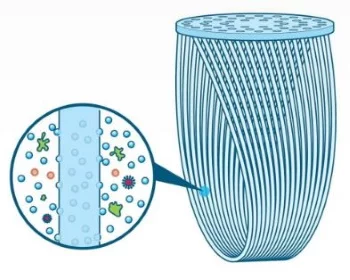
I figured out that the reason this filter lasts so long is that it does not catch tiny viruses. This really shouldn’t be a problem here in the states, as it does catch the common E. Coli, Giardia, and Salmonella.
Personally, I would rather spend the money for virus protection if purchasing for emergency water filtration device.
If using for hiking, backpacking, and camping it should be okay.
Before taking out on a trek, test the unit thoroughly as users have reported leakage and breakage.
The website claims to have a lifetime warranty, but the company’s interpretation of “lifetime” is questionable as some users had issues with returning broken products.
Overall, it’s a good purification system for filtering wild water, but I do not recommend it for emergency situations like flooding and boil orders.
Best Value:
Survivor Filter PRO Water Purifier

Pros
- Removes all impurities, including viruses
- Rugged construction
- 17 ounces of clean water per minute
Cons
- Pumping mechanism can become cumbersome
- Moving parts have a chance of breaking
- Three filters to change out
This is done through a three filter method – the pre-filter, carbon filter, and internal ultrafilter.
The unit makes for a great companion for international travel, municipal water sources under boil order, and emergency water purification.
The pump is made of heavy-duty material that should withstand many uses and rugged environments.
My main concern is having to manually pump for fresh water. This could be quite tiring, especially if used for multiple people. Best to take turns.
My other concern is that since it has moving parts, it could break. Luckily, it comes with a lifetime warranty if you register the unit.
Note that the carbon filter will only last for 2,000 liters as opposed to the other two filters.
Overall, this is a great choice for a filter as it removes a comprehensive amount of contaminants and viruses. Good for emergency water situations, just be prepared for a workout!
Recommended Product:
Potable Aqua Water Purification Treatment (50 Tablets)

No matter what, ALWAYS have water purification tablets handy for a backup purifying system!!!
Best Emergency Home Water Filter
I have chosen these products for an emergency event where you can purify your water while at home. These systems are a good option for municipalities under boil orders and bug in situations.
These systems also work well for everyday use and for well water or off grid water systems.
Best Overall:
Royal Berkey Water Filter

Pros
- 3.25 gallons of purified drinking water per day
- Removes fluoride and pharmaceuticals (with additional filter)
- High quality durable ceramic filtration
Cons
- Filters can clog prematurely
- Washers and stoppers are made of rubber leaving a funny taste
- Will not ship to CA or IA
The Royal Berkey water filter is an ideal choice for providing clean drinking water in an emergency situation.
The filter removes all sorts of contaminants including bacteria, pathogens, viruses, chlorine, industrial chemicals, herbicides, pesticides, and even fluoride if you purchase the additional fluoride filter.
This unit uses gravity to filter water, so no electricity or plumbing needed.
The capacity is quite large in relation to the size of the unit, which is 23″ by 9″.
The filtration elements can be cleaned, which allows for a long lifespan of 6,000 gallons.
However, the filters can clog prematurely if high concentrations of sediment travel through the filters. I recommend purchasing a whole house water filter to remove heavy sediments before running through the filter, especially for well water and off grid water systems.
I also recommend replacing the rubber stoppers and washers as these can cause some odors and tastes in the water.
Overall, the Royal Berkey water filter is an excellent emergency water filtration system that can be transported and also looks good on the countertop.
Recommended Product:
HQUA-OWS-12 Ultraviolet Water Purifier Sterilizer Filter
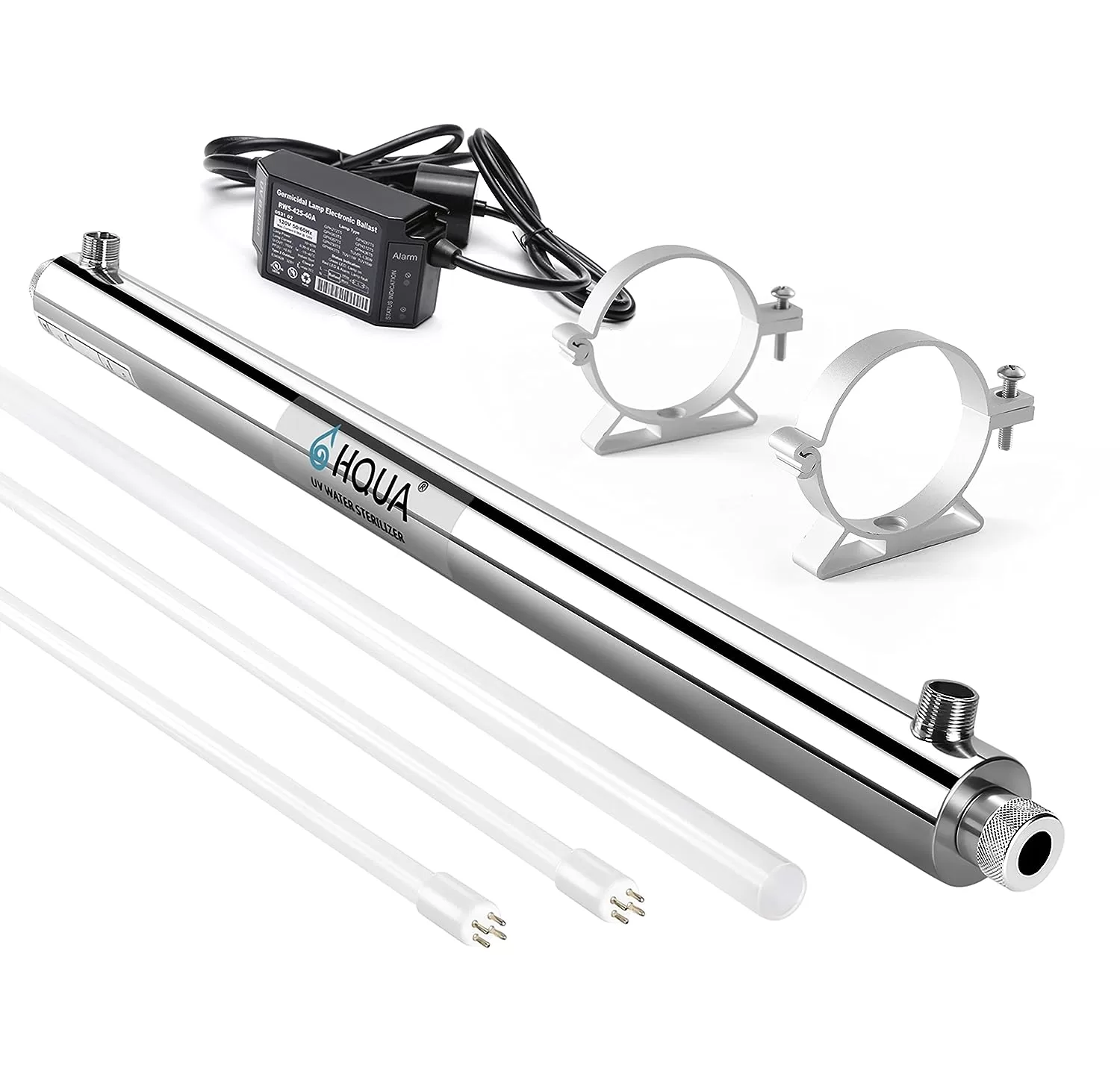
This ultraviolet water purifier will eliminate bacteria and viruses in your water which pairs up nicely with the Woder filter.
Just take note that it does require power to run so keep a small backup generator handy in case you lose power.
Top Product:
Aquasana Whole House Well Water Filter System w/ UV Purifier and Salt-Free Descaler

Pros
- Comprehensive filtration system removes scale and microbes
- Filters and purifies 500,000 gallons of water
- Heavy duty system built to last
Cons
- Very high end price point
- Will likely require professional installation
- Pre and post filters will need more frequent replacing
This Whole House Aquasana water filter is the mega ultimate of all filters! If you want to go all out for the highest quality of water then this is the filter for you.
The filter’s main carbon chamber will last for 500,000 gallons or five years. Note that additional filters will require more frequent replacements.
This model comes with a built-in UV disinfection system. The bulb will need to be replaced yearly and does require electricity to run. You will want to have a small backup generator to keep the UV filter running in times of power outages.
This filter has six stages of water treatment along with a salt-free water conditioner which is ideal for treating well water systems.
This unit is very expensive and the cost of the replacement filters will add up over time. However, the main and most expensive filter will not have to be changed out for 500,000 gallons and the unit comes with a long 5 year warranty.
Overall this is one of the best choices for water filtration and purification and will last through an emergency water event so long as the UV light system is provided with power. Be prepared to drop a wad of cash!
Conclusion
It's wise to have an emergency water filtration system in place before an emergency happens, as opposed to waiting for a distaster to happen and not have the water filtration equipment on hand.
I hope you have found my article on the best emergency water filters both informative and entertaining. Now you can make a sound decision on your purchase suiting your unique situation.
If you are interested in more preparedness tips, check out my Ultimate Bug Out Bag Contents Listed and Explained.
Please feel free to leave me any questions or comments and share my article.


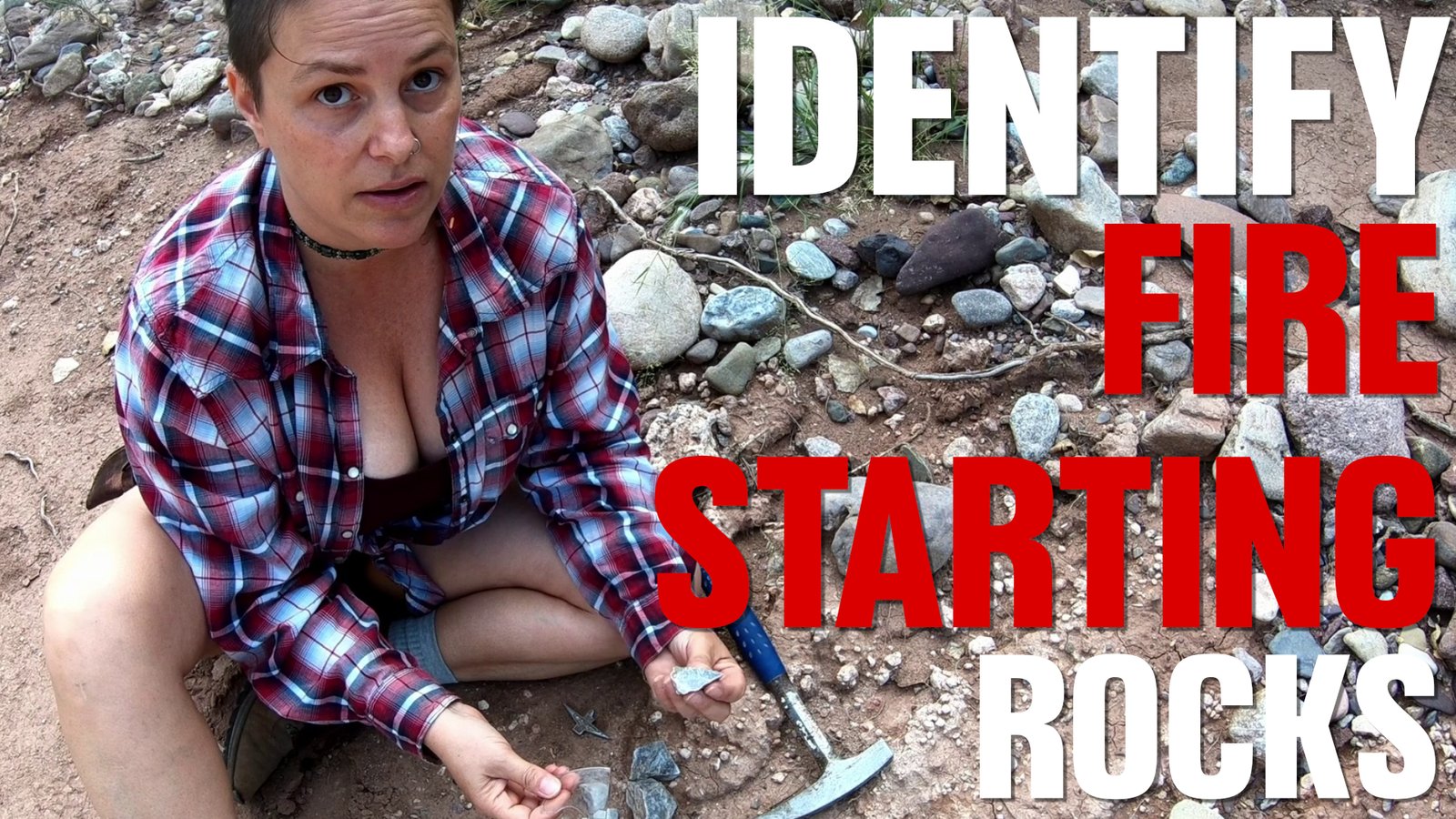


would you recommend if possible to clean off the rocks sand bio char etc before configuring the bottle? and would steaming the charcoal help make it absorb the nasty stuff better.
Great article simple and helpful.
Thanks! After you are assembling everything, you can run water thru your setup until it runs clear of any residues on the materials. I don’t think its possible to actually wash the components clean before use, but remove as much debris as you can.
As far as the activated carbon goes, I would not steam it, rather let the water run thru it slowly as it catchs the microbes in the tiny pores of the charcoal.